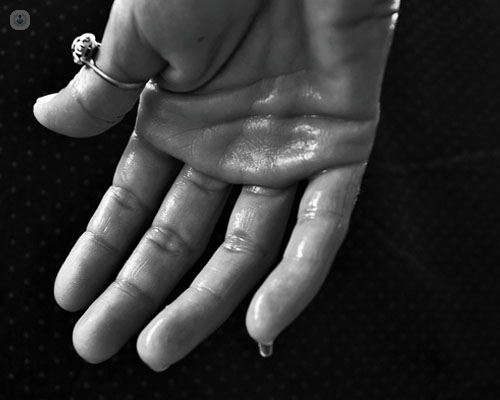Minimally invasive solution of palmar and axillary hyperhidrosis
Written by:Excessive sweating in the hands and underarms, usually associated with increased sweating in the soles of the feet, is known as palmar, axillary and plantar hyperhidrosis. Such hyperhidrosis is often considered "primary" because its causes are unknown.
There is a small family predisposition and a higher incidence of this condition in the female sex. The affected patients remember to suffer an increase of sweating from small, which prevented them to maintain a normal relation with their companions, by the rejection that they suffered to the contact of the hands. And is that sweating in hands also causes problems with writing, as some children must use blotting paper and also the ink moves from the papers they write.

Likewise, the usual act of holding hands represents in patients with hyperhidrosis a problem, because of the feeling of displeasure that the other person will perceive when noticing sweat. Derived from all this problem, patients are given a natural state of nervousness which, in many cases, has been considered the cause, reaching to treat patients with tranquilizers. However, nervousness is not the cause , but a circle in which more sweating is added more uneasiness .
Treatments available for hyperhidrosis
Currently there are multiple local treatments, such as aluminum chloride in alcoholic solution, tannic acid, iontophoresis as a transcutaneous treatment, among others. All of these treatments may decrease the severity of sweating but, because it is a lifelong treatment, patients often abandon it. Botulinum toxin injections are another alternative for patients who do not want to undergo operations. It is advised for axillary hyperhidrosis or areas such as the submammary fold or forehead. It is an aggressive but painful intervention in the hands and with a temporary effect, so it should be repeated every 4-6 months.
Surgical treatment of hyperhidrosis: videothoracoscopic surgery
Surgical treatment is usually applied in the palmar and axillary hyperhidrosis, interrupting the nervous pathway through which the perspiration stimulus is propagated and the sympathetic pathway is exaggerated.
The technique is thoracic sympathectomy and must be performed in both hemithorax separately, to resolve the bilateral condition. However, until about 25 years ago, it was not recommended by thoracic surgeons because the chest should be opened thoracotomy and the intervention could be more aggressive than the condition. However, for about 20 years the surgery can be performed by videothoracoscopic surgery , so it is not necessary to open the chest, since it can be performed through a hole of 1cm on each side.
It is an effective technique, since the procedure is performed under general anesthesia and the patient wakes up with dry hands, being discharged in 6-12 hours, to resume their usual tasks in one or two days. The results of this surgery, in fact, are of a complete resolution of the palmar and axillary hyperhidrosis in 99% of the cases .
After the intervention, there may be some minor side effects, such as the patient's notice of very dry hands (solvable with moisturizing cream), in cases of patients undergoing axillary hyperhidrosis. Likewise, mild sweating at the level of the back or thighs (compensating hyperspiration) may occur in four out of 10 patients, which is not comparable to that experienced in the hands or underarms, with the exception of some cases in which sweating is more severe .
For 10 years, the operation for palmar, axillary and facial flushing hyperhidrosis was performed by interrupting the sympathetic chain (without cutting it) using a titanium clip (Clipping) so that if there was a very severe compensatory sweating (Occurring in 1-2% of cases), we could theoretically remove the clips and improve it.
In summary, the occurrence of minimally invasive thoracic surgery has shown that many patients with palmar and axillary hyperhidrosis can benefit from this less aggressive technique with excellent results and that their concern disappears, feeling once again a "normal" person.


